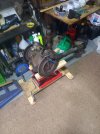Hi All
This may be a stupid question , first big job on my P6 1974 2200 TC
I am going to remove the diff primarily to fix rear brake calipers, not working, but also have oil leak from extension tube seal and rear hanger mounts look shot.
Workshop manual (Haynes) does not mention the cross car beam that the lower suspension links mount to... only the xtube mounting bracket.
Will the front drive flange of the diff extension tube pass between xbeam and floor, or am I missing something.
Help it's driving me mad thinking it through
Howard
This may be a stupid question , first big job on my P6 1974 2200 TC
I am going to remove the diff primarily to fix rear brake calipers, not working, but also have oil leak from extension tube seal and rear hanger mounts look shot.
Workshop manual (Haynes) does not mention the cross car beam that the lower suspension links mount to... only the xtube mounting bracket.
Will the front drive flange of the diff extension tube pass between xbeam and floor, or am I missing something.
Help it's driving me mad thinking it through
Howard



